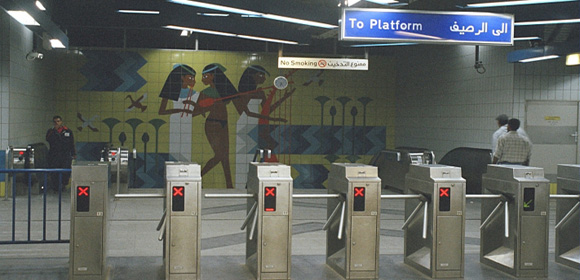- Washington “follows with interest” Morocco’s openness onto Africa (John Kerry)Posted 11 years ago
- The trial of South African Paralympic champion Oscar Pistorius opened in Pretoria on Monday.Posted 11 years ago
- USA welcomes efforts of King Mohammed VI in MaliPosted 11 years ago
- Egypt’s population reaches 94 millionPosted 11 years ago
- Mugabe celebrates his 90thPosted 11 years ago
- Moroccan Monarch to Build a Perinatal Clinic in BamakoPosted 11 years ago
- King Mohammed VI handed a donation of bovine semen for the benefit of Malian breeders.Posted 11 years ago
- Moroccan King’s strategic tour to Africa: Strengthening the will of pan African Solidarity and stimulating the south-south cooperation mechanisms over the continentPosted 12 years ago
- Senior al-Qaida leader killed in AlgeriaPosted 12 years ago
- Libya: The trial of former Prime Minister al-Baghdadi AliPosted 12 years ago
Egypt: The Cairo metro network
 The Cairo metro adventure started in the 1980s, with INCI, Bouygues and Alstom companies. Since then, the subway has become a vital mean of transport, avoiding the chaotic traffic that clogs the Egyptian capital. The two existing lines carry nearly four million passengers per day. According to the World Health Organization, Cairo, the megalopolis of 18 million inhabitants, is one of the ten most polluted cities in the world.
The Cairo metro adventure started in the 1980s, with INCI, Bouygues and Alstom companies. Since then, the subway has become a vital mean of transport, avoiding the chaotic traffic that clogs the Egyptian capital. The two existing lines carry nearly four million passengers per day. According to the World Health Organization, Cairo, the megalopolis of 18 million inhabitants, is one of the ten most polluted cities in the world.
Thus the extension of the subway has become more than urgent, and Since July 2007 when the Vinci teams had started digging the third metro line tunnel in the Egyptian capital. This third line will cross the city from east to west, connecting the airport to the “Mohandessin” district. Line 3 was originally planned to run from Embaba in the northwest to Salah Salem in the east crossing both existing lines in the city centre. Later the project was modified and the eastern leg will now end at the Airport. Line 3 will be 33 km with 29 stations, of which 27 will be underground. It will be built in 4 phases: For now, about 2600 persons – engineers and workers, are busy on the site. A consortium of four companies is performing the civil engineering works: Vinci, Bouygues and two Egyptian companies, the Arab Contractors and Orascom. They are sharing a budget of 540 million Euros for Phases 1 and 2 consisting of nine stations. But carrying out such civil works in this site is a constant challenge. The water table, in the downtown is a few meters from the surface: the basement is composed of sand and water, so, they use a “mud pressure” equipments, adapted to this soil type. Another danger when you dig in Cairo is about the high probability to cut underground networks of water, gas or telecommunications. It is not uncommon that network maps do not correspond to the reality; thus adding more load to the Vinci teams to make their own scanning before drilling the ground. The first four stations of Line 3 should open in October 2011. But to travel between the two ends of the line would be possible by 2022, and Vinci Company will have to run enough business in Egypt for a long time, and why not for the projected underground fourth Line.
